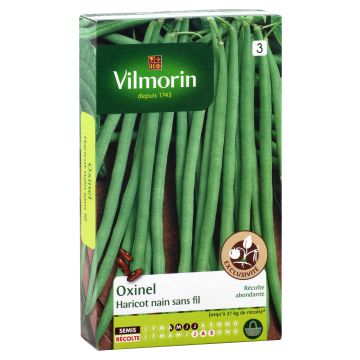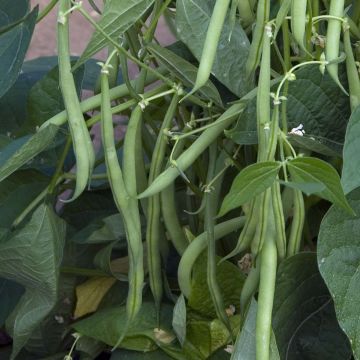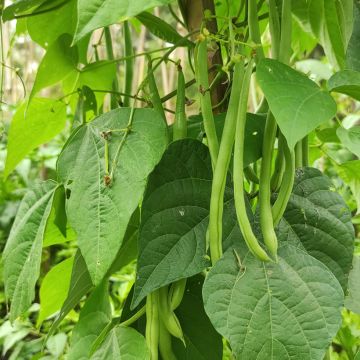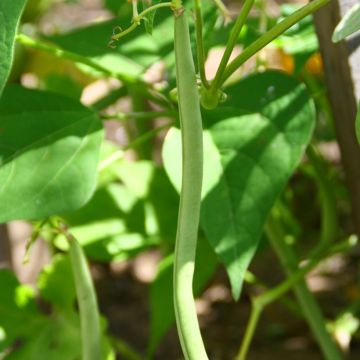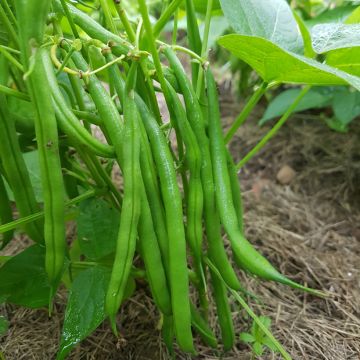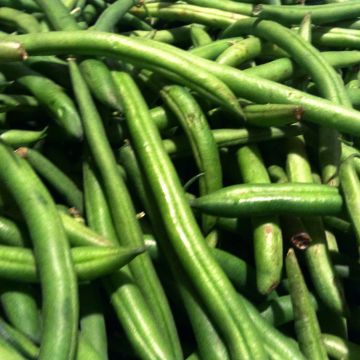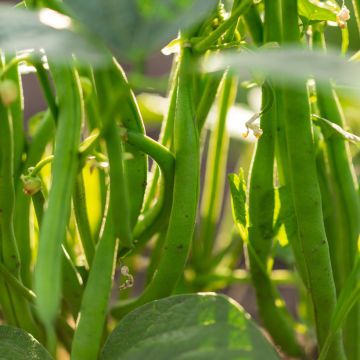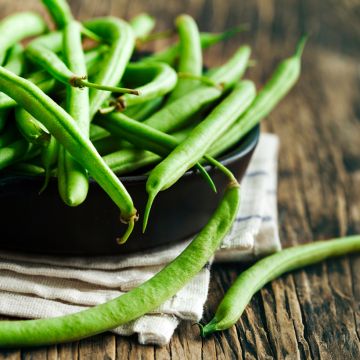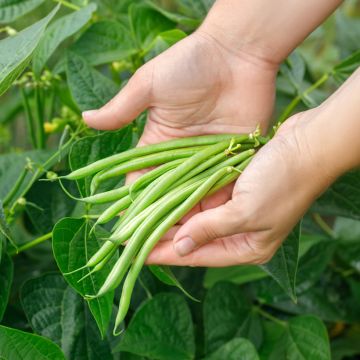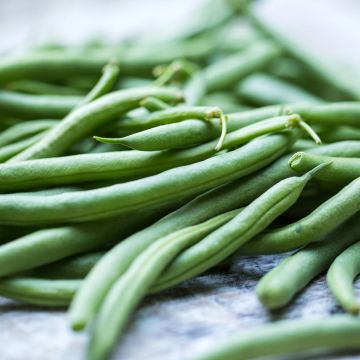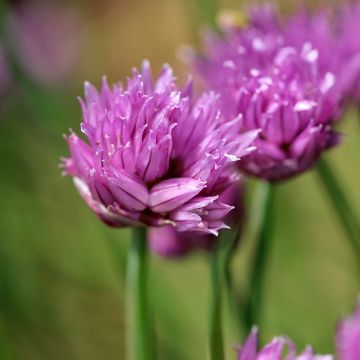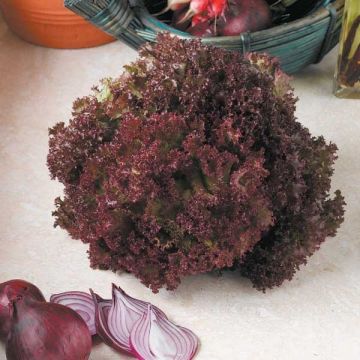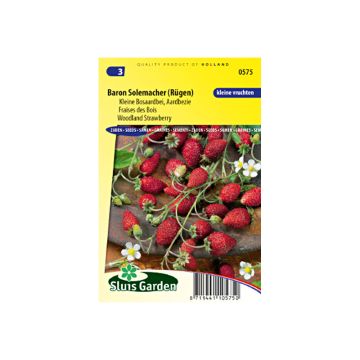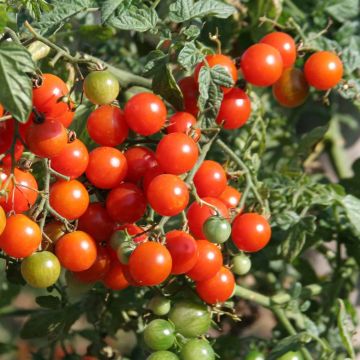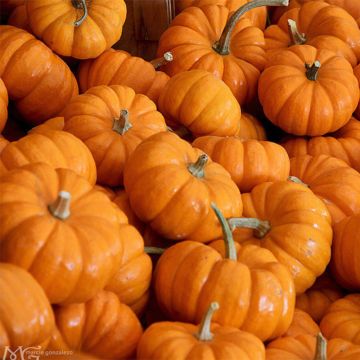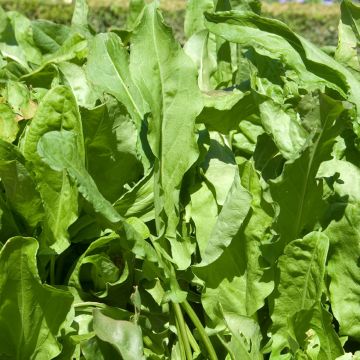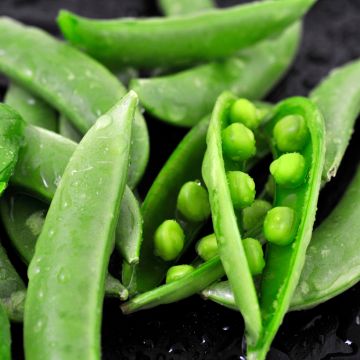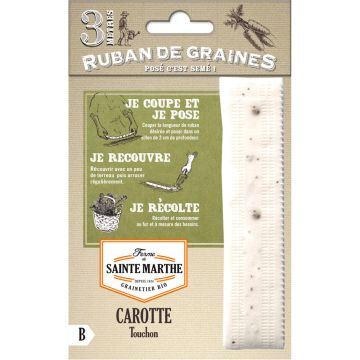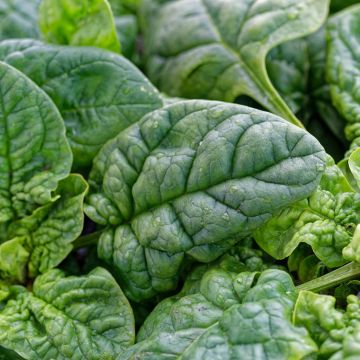

Climbing bean with net Fasold
Phaseolus vulgaris Fasold
Common bean, French bean, Green bean
It's the first time I've grown it. Indeed, it's a very productive variety. For the gardener, seeing these beautiful and long pods is very enjoyable. As for its qualities, don't jump to conclusions too quickly. But when it comes to the taste, I don't share the enthusiastic comments. This bean is pleasant in the mouth but bland. I cook with little seasoning and clearly, compared to other varieties, it has little flavor. However, I would still use it again for its productivity and lack of strings overall.
Didier, 31/08/2019
Order in the next for dispatch today!
Dispatch by letter from €3.90.
Delivery charge from €5.90 Oversize package delivery charge from €6.90.
Current delivery delay: 2 days.
More information
This item is not available in your country.
Schedule delivery date,
and select date in basket
This plant carries a 6 months recovery warranty
More information
We guarantee the quality of our plants for a full growing cycle, and will replace at our expense any plant that fails to recover under normal climatic and planting conditions.
Seed-only orders are dispatched by sealed envelope. The delivery charge for seed-only orders is €3.90.

Description
Phaseolus vulgaris 'Fasold' is a very early climbing bean. It bears a multitude of delicate purple flowers, followed by a bountiful harvest of delicious green beans. It is generally recommended to pick the beans as they ripen. If left unpicked, the beans will retain their freshness. It reaches 1.8m (6ft) in height so will need staking as soon as possible. Sow the seeds from April to July for a harvest from late May to the end of September.
These bean plants are highly aesthetic. They will create beautiful displays on bamboo canes to form a vegetal wall. Place the seeds at the base of the supports.
Whether consumed for its pod or its seed, the bean is a highly appreciated vegetable in gardens because it is very easy to grow. It is so reliable that the gardener knows the exact date of its first harvest, which is 60 days after sowing.
Discovered in the New World and acclimatised in Europe from the 16th century onwards, the bean has now become an essential legume in diets all over the world. Native Americans cultivated it for its dried seeds. In the 18th century, the Italians initiated the consumption of the whole pod by picking it immature.
Beans are a vine plant with indeterminate growth. Primitive varieties are all climbing plants and require support. Later, for practical reasons, dwarf varieties were selected, but they all have tendrils that can wrap around a support.
The pods are generally green, sometimes yellow (butter beans), striped with red, or even amethyst. Among the varieties that are eaten at the fine or extra-fine stage, there are string beans that develop strings when fully ripe. Then the pod becomes parchment-like and loses its taste quality.
The snap bean is generally fleshier and can be consumed entirely, with both the seeds and the pods, even when fully ripe. The more recently created stringless-snap beans can be consumed when young and extra-fine until they become fleshier like a snap bean, as they do not form strings.
Among the shell beans (i.e., beans whose seeds are consumed), a distinction is made between the harvest of fresh beans and that of dry seeds, which is done 90 days after sowing.
Immature green pods are rich in vitamins A, B9, and C, as well as trace elements and minerals. Dry beans are also very rich in vitamin C, trace elements, and especially vegetable proteins.
Harvest: the harvest of fresh beans or young pods begins 60 days after sowing. For fresh beans, harvest before the pods start to dehydrate and develop wrinkles. The beans should barely take on their colour. For the consumption of pods, the harvest should take place every 2 or 3 days, both at the fine and extra-fine stage for string beans. Harvest dry beans by cutting the whole plant and hanging it in a dry and airy place. They can be shelled as needed.
Storage: freezing pods is currently the most common method of preservation. To do this, they should be trimmed, washed, blanched for 5 to 6 minutes in boiling water, and then plunged into cold water before drying them with a clean towel. Once packaged, the beans can be placed in the freezer at -18°C (-0.4°F). However, canning is regaining its popularity among an increasing number of consumers due to the taste qualities inherent in this preservation method. Like with freezing, trim, wash, blanch, and then plunge the beans into cold water. Then place them in jars, filling them with salted boiling water. Seal the jars and sterilise them in a pressure cooker or with a steriliser for 1 hour and 30 minutes over medium heat. To do this, completely cover the jars with water after securing them well. Completely dry bean seeds can be stored for up to one year in good conditions, such as in airtight jars.
The gardener's tip: like all members of the Fabaceae family, beans can fix nitrogen from the air in the soil through a plant-bacteria symbiosis. They can regenerate soils. Beans can be incorporated into crop rotation after mixing in green manure.
Beans are not very demanding in terms of nutrients. Traditionally, the cultivation of beans in Central and South America is associated with the cultivation of squash and corn, forming a beneficial triad. This association is locally called Milpa. Beans also work well with aubergine, carrots, cabbage, potatoes, and radishes as they mutually protect each other. However, avoid planting them near alliums or fennel, as their growth will be inhibited.
A spray of nettle manure is an effective control of aphids. It also strengthens the plants that have benefited from it.
Report an error about the product description
Harvest
Plant habit
Foliage
Botanical data
Phaseolus
vulgaris
Fasold
Fabaceae
Common bean, French bean, Green bean
Cultivar or hybrid
Annual
Other String beans
Planting and care
Soil preparation
It likes light, moist but not damp, nutrient-rich soil. However, it does not appreciate soils that are too chalky or too acidic. Prepare the soil by digging to a depth of 20cm (8in), without turning the soil. Add compost or well-decomposed manure. Do not sow the bean in soil that has been recently limed as this causes hardening and loss of the pod's taste quality.
Sowing under glass
Sow as early as mid-March under glass or in tunnels. It is a frost-sensitive vegetable and requires a minimum soil temperature of 15°C (59°F). The glasshouses should face south or west. Only ventilate them during the warm hours of the day. Only remove any protection when there is no longer a risk of frost.
Sowing in open ground
Sow from April in southern regions, or from May when the soil is sufficiently warmed up and there is no longer a risk of frost. Dig furrows 3 to 4cm (1 to 2in) deep, spaced 40cm (16in) apart. Sow your seeds with a spacing of 5 to 7cm (2 to 3in), or in groups of 4 to 5 seeds spaced 40cm (16in) apart in all directions. Cover the soil and lightly tamp it down with a rake. When the plants reach a height of 20cm (8in), hill up the stems to provide support.
The first harvests take place approximately 60 days after sowing and continue until the end of October. Sow beans every 15 days for a continuous harvest until the end of autumn.
There are different types of support for climbing beans: Canadian tent, teepees, on nets, or trellises. Any tall structure can become the support for this type of bean, which then takes on a very aesthetic appearance.
Seedlings
Care
Intended location
-
, onOrder confirmed
Reply from on Promesse de fleurs
Vegetable seeds
Haven't found what you were looking for?
Hardiness is the lowest winter temperature a plant can endure without suffering serious damage or even dying. However, hardiness is affected by location (a sheltered area, such as a patio), protection (winter cover) and soil type (hardiness is improved by well-drained soil).

Photo Sharing Terms & Conditions
In order to encourage gardeners to interact and share their experiences, Promesse de fleurs offers various media enabling content to be uploaded onto its Site - in particular via the ‘Photo sharing’ module.
The User agrees to refrain from:
- Posting any content that is illegal, prejudicial, insulting, racist, inciteful to hatred, revisionist, contrary to public decency, that infringes on privacy or on the privacy rights of third parties, in particular the publicity rights of persons and goods, intellectual property rights, or the right to privacy.
- Submitting content on behalf of a third party;
- Impersonate the identity of a third party and/or publish any personal information about a third party;
In general, the User undertakes to refrain from any unethical behaviour.
All Content (in particular text, comments, files, images, photos, videos, creative works, etc.), which may be subject to property or intellectual property rights, image or other private rights, shall remain the property of the User, subject to the limited rights granted by the terms of the licence granted by Promesse de fleurs as stated below. Users are at liberty to publish or not to publish such Content on the Site, notably via the ‘Photo Sharing’ facility, and accept that this Content shall be made public and freely accessible, notably on the Internet.
Users further acknowledge, undertake to have ,and guarantee that they hold all necessary rights and permissions to publish such material on the Site, in particular with regard to the legislation in force pertaining to any privacy, property, intellectual property, image, or contractual rights, or rights of any other nature. By publishing such Content on the Site, Users acknowledge accepting full liability as publishers of the Content within the meaning of the law, and grant Promesse de fleurs, free of charge, an inclusive, worldwide licence for the said Content for the entire duration of its publication, including all reproduction, representation, up/downloading, displaying, performing, transmission, and storage rights.
Users also grant permission for their name to be linked to the Content and accept that this link may not always be made available.
By engaging in posting material, Users consent to their Content becoming automatically accessible on the Internet, in particular on other sites and/or blogs and/or web pages of the Promesse de fleurs site, including in particular social pages and the Promesse de fleurs catalogue.
Users may secure the removal of entrusted content free of charge by issuing a simple request via our contact form.
The flowering period indicated on our website applies to countries and regions located in USDA zone 8 (France, the United Kingdom, Ireland, the Netherlands, etc.)
It will vary according to where you live:
- In zones 9 to 10 (Italy, Spain, Greece, etc.), flowering will occur about 2 to 4 weeks earlier.
- In zones 6 to 7 (Germany, Poland, Slovenia, and lower mountainous regions), flowering will be delayed by 2 to 3 weeks.
- In zone 5 (Central Europe, Scandinavia), blooming will be delayed by 3 to 5 weeks.
In temperate climates, pruning of spring-flowering shrubs (forsythia, spireas, etc.) should be done just after flowering.
Pruning of summer-flowering shrubs (Indian Lilac, Perovskia, etc.) can be done in winter or spring.
In cold regions as well as with frost-sensitive plants, avoid pruning too early when severe frosts may still occur.
The planting period indicated on our website applies to countries and regions located in USDA zone 8 (France, United Kingdom, Ireland, Netherlands).
It will vary according to where you live:
- In Mediterranean zones (Marseille, Madrid, Milan, etc.), autumn and winter are the best planting periods.
- In continental zones (Strasbourg, Munich, Vienna, etc.), delay planting by 2 to 3 weeks in spring and bring it forward by 2 to 4 weeks in autumn.
- In mountainous regions (the Alps, Pyrenees, Carpathians, etc.), it is best to plant in late spring (May-June) or late summer (August-September).
The harvesting period indicated on our website applies to countries and regions in USDA zone 8 (France, England, Ireland, the Netherlands).
In colder areas (Scandinavia, Poland, Austria...) fruit and vegetable harvests are likely to be delayed by 3-4 weeks.
In warmer areas (Italy, Spain, Greece, etc.), harvesting will probably take place earlier, depending on weather conditions.
The sowing periods indicated on our website apply to countries and regions within USDA Zone 8 (France, UK, Ireland, Netherlands).
In colder areas (Scandinavia, Poland, Austria...), delay any outdoor sowing by 3-4 weeks, or sow under glass.
In warmer climes (Italy, Spain, Greece, etc.), bring outdoor sowing forward by a few weeks.


































